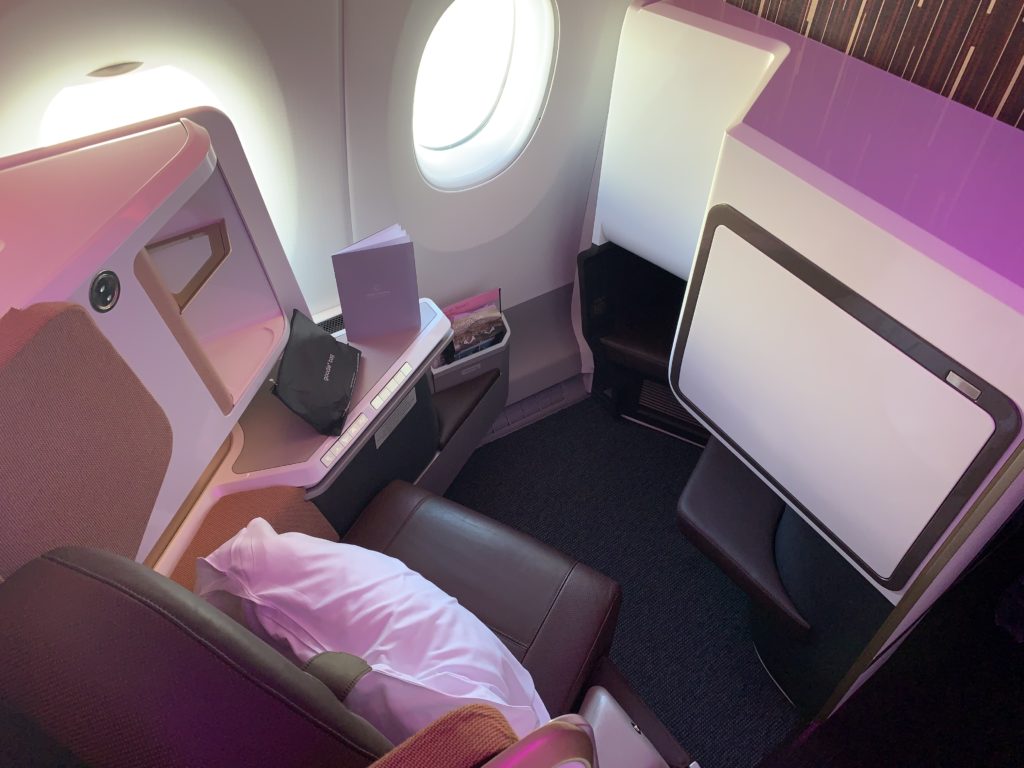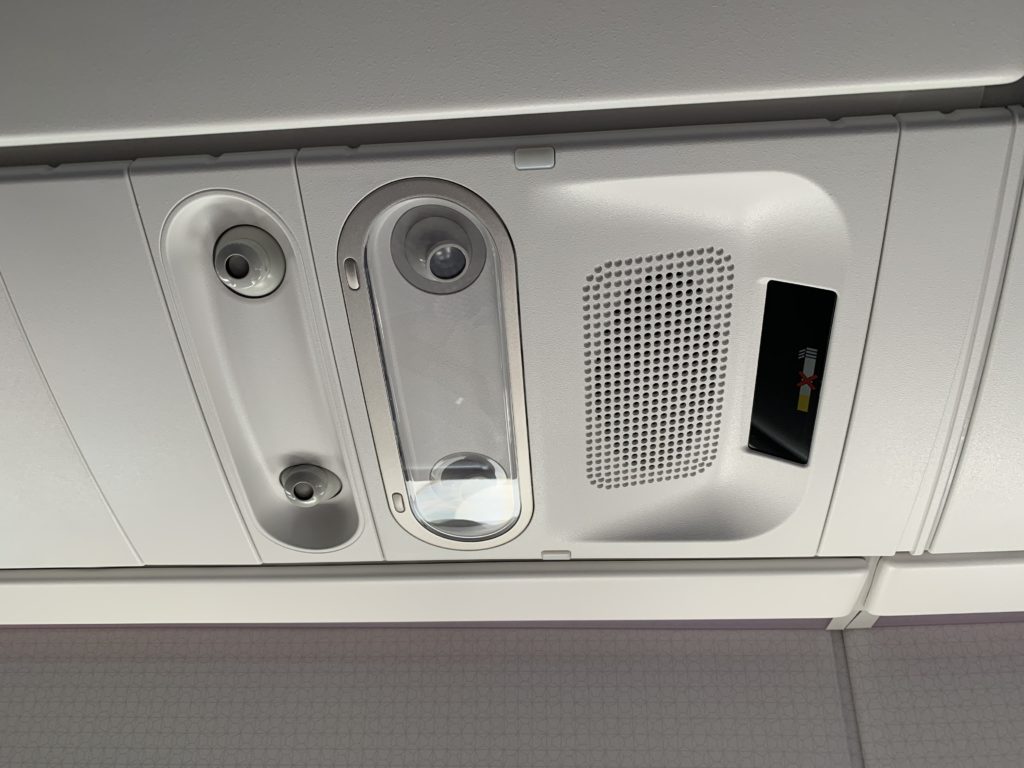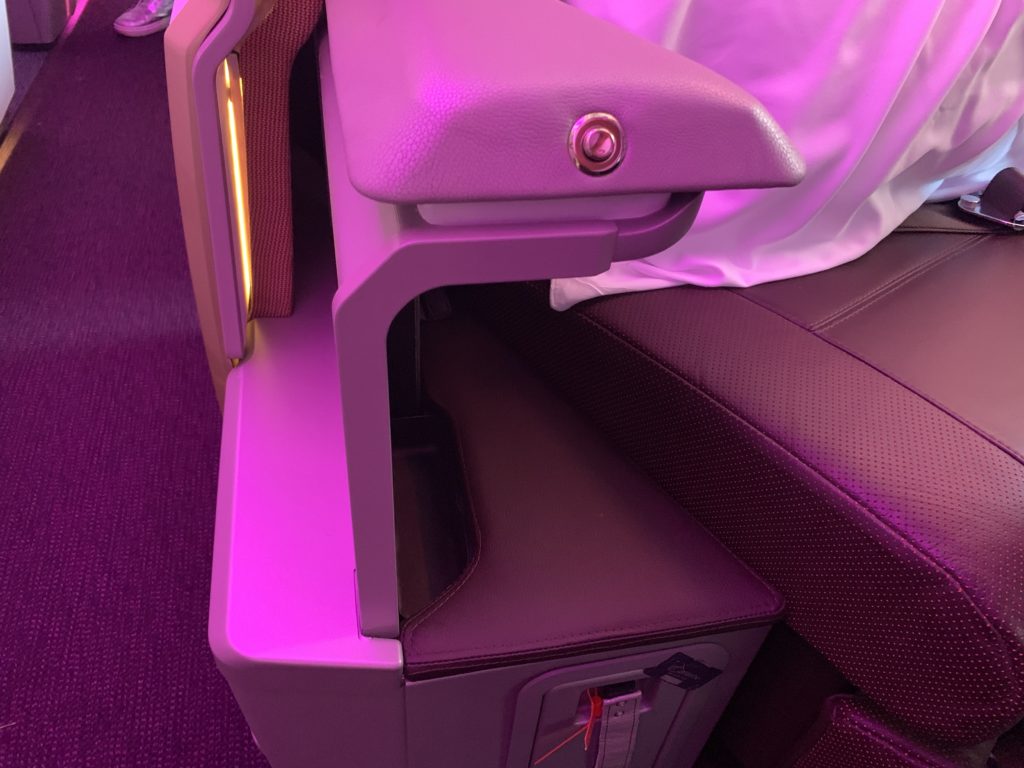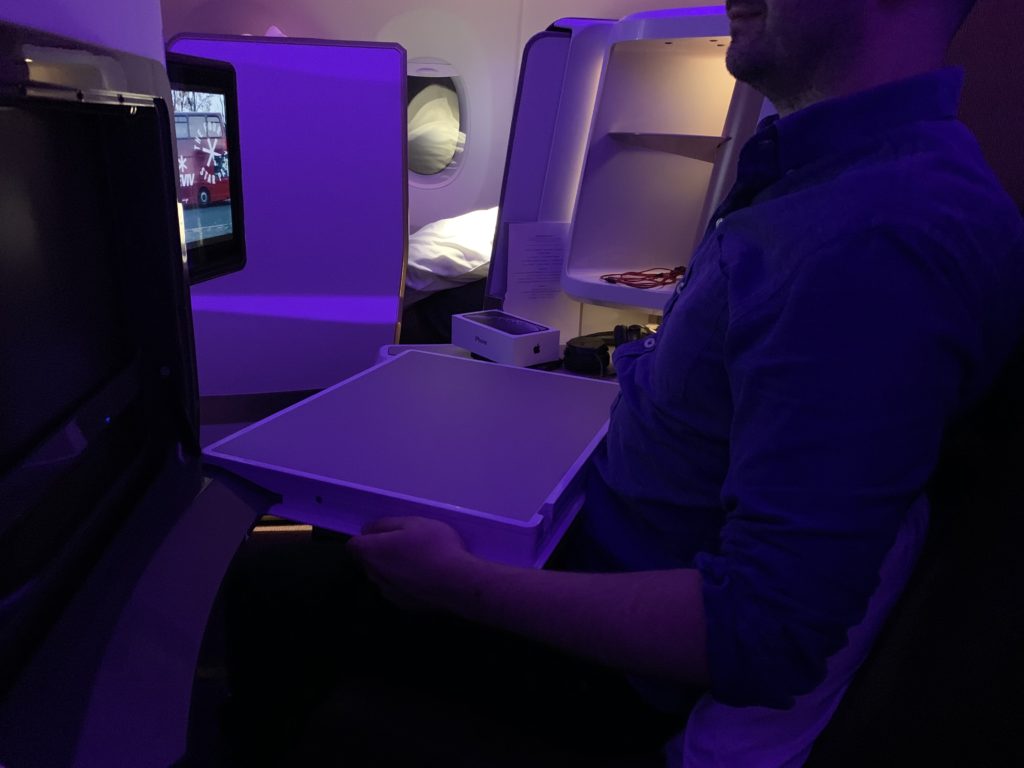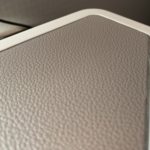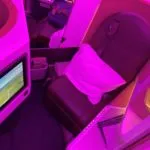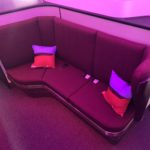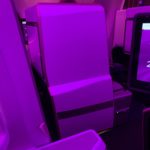 During a sort of #PaxEx duel between the UK’s two largest airlines, British Airways and Virgin Atlantic, each is launching a new business class on board their Airbus A350 aircraft. Whereas British Airways chose Collins Aerospace’s Super Diamond with a door, Virgin plumped for the Safran Seats Cirrus NG without.
During a sort of #PaxEx duel between the UK’s two largest airlines, British Airways and Virgin Atlantic, each is launching a new business class on board their Airbus A350 aircraft. Whereas British Airways chose Collins Aerospace’s Super Diamond with a door, Virgin plumped for the Safran Seats Cirrus NG without.
At the launch of the Cirrus NG on Virgin’s A350, the line “Virgin is a social airline” was rolled out numerous times to explain the doorless decision. After a whistlestop return from London Heathrow to New York JFK, the potential reasons for it became somewhat clearer.
Notably, Virgin Atlantic (which, full disclosure, put on a special media trip and provided connecting intra-European flights and accommodation throughout the journey) also made the unusual decision to set the media flight for the week after the aircraft’s first in-service flight. On the one hand, this allows for some of the teething problems to be ironed out; on the other, expectations that the ironing out has happened must be higher as a result.
It feels rare these days that a business class seat enters smoothly into service, and Virgin Atlantic’s new A350 Upper Class seat was no different. For a passenger experience journalist familiar with the companies and history concerned, it is hard to analyze this seat without acknowledging its manufacturer context.
RGN readers will be familiar with the problems these pages have chronicled with Safran Seats’ build quality and robustness, which date at least as far back as its Zodiac Aerospace days, and particularly with the Airbus A350 implementation for Cathay Pacific
Regrettably for Virgin Atlantic — which made its choice of Cirrus NG for its Airbus A350 before the Zodiac problems became quite so clearly evident — these quality problems are evident here too, and were noticed even by media not quite so steeped in the weeds of the passenger experience supply chain as RGN. But on to those shortly.
Inside the seats and cabin
The basics of the cabin are good. The herringbone seat is arranged in a 1-2-1 configuration, in a new mixed pattern where window seats face towards the window, as indeed do those in the centre section, so passengers in the middle have their heads closer to each other.
This is remarkably successful: quiet discussion was possible in the centre section, while all seats felt surprisingly private despite the lack of door. Indeed, the offset of each row and the mixed herringbone layout means that from the centre seats one is facing not another passenger but the shroud of their seating.
A consequence, though, is that the six-inch privacy divider on the outboard feels like it does very little indeed, while the privacy divider in the centre feels like it could truly add some value by being another six inches longer. In honesty, with hindsight the aisle-side privacy dividers and perhaps the window-side ones as well could have easily been removed from the centre seats with little impact apart from creating extra space.

The privacy screen doesn’t help and, honestly, feels a little daft given its minuscule size. Image: John Walton
In look and feel, it is very Virgin and, though this is all subjective, very successful. A series of differently textured white thermoplastics in a series of colors reflect the moodlighting well, with accents in almond gold, chocolate leather and a sort of burnt orange. Accent lighting is thoughtful and well chosen, although presently unable to be turned off overnight for some reason, and some of the seat switches did not function correctly.

The internal lighting is nice, but there seemed to be a bug where it couldn’t be dimmed on the return overnight flight, even a week after entry into service. Image: John Walton
Seats in the front row have substantially more room as the result of choices to not tuck the footwells into the monuments in front, and while Virgin Atlantic rather cleverly booked RGN into row 1 seats in both directions, this journalist swapped with a friend into row 2 on the overnight return to experience the sleeping space of the regular seat.
Seat comfort was surprisingly good, perhaps the best in any modern business class seat your author has experienced thanks to the impressive cushioning. The foams were very ample, and the leather soft and buttery to the touch, while the fitted mattress pad added comfort and breathability for both a nap on the westbound and a good few hours’ kip on the eastbound redeye.
Notably, though, despite an executive suggesting passengers could take off with the mattress pad installed, à la Qantas Business Suite, there is no slot for the over-shoulder belt to slip through, so this is not an option at present.

The mattress pad is comfortable, but misses the slot for the overshoulder belt to enable gate-to-gate usage. Image: John Walton
Even for a larger-framed passenger, multiple sleeping positions were comfortable, and passengers used to the untrammelled space on Virgin’s original 747 Upper Class Suite (less so on the newer, narrower A340, 787 and A330-300 versions) will be pleased by the well-sized footwell and wide shoulder space even behind row 1.
Your journalist was, in fairness, not expecting the new seat — which reclines to flat rather than flipping over like the last generation — to be as comfortable as its predecessor in sleeping mode, but it was.
Other pluses included individual air vents for every passenger, which are increasingly rare but very welcome, and of course the A350’s higher cabin humidity and lower cabin altitude, which reduce fatigue.
There are, however, some flaws with the Safran Seats, some in the process of being fixed and some harder to remedy.
A crucial immediately perceivable issue with the seats is a lack of storage: neither the space on nor under the ottoman has been certified for takeoff and landing stowage. While the glass shelf is impressive from a certification perspective, it’s no practical substitute for a little locker, and the movable up-down triangle compartment between the centreline and the seat angle is just an armrest here. Virgin has kept the centre overhead bins — it couldn’t not, really — but having to hop up and down to tuck away your iPad or make sure your wireless headphones don’t get lost down the seat is really rather less than ideal.
In window seats, the actual windows are blocked by the IFE screen when deployed and particularly by the shoulder-level shroud that surrounds the two cocktail tables, meaning that with the IFE deployed it is remarkably frustrating to try to see what is outside. This is regrettable and hard to fix.
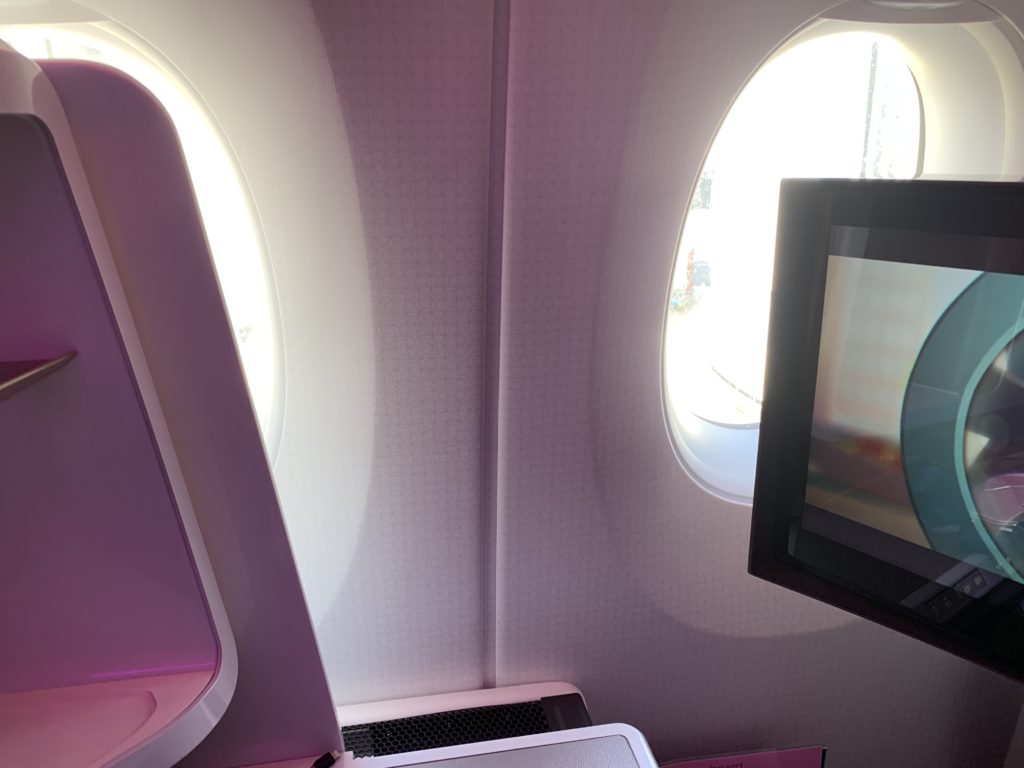
One unfortunate flaw is that the window-side shrouding and the screen block any window view at all. Image: John Walton
The worst issue, though, is the table, which folds down in its entirety from the seatback in front. It is too large, does not permit easy egress in the down position, and even average-sized passengers may find it uncomfortable. I am truly baffled that this problem wasn’t identified before entry-into-service.
As reported by RGN, Virgin is fixing this problem, and fast: there is a new table due to be retrofit onto the first set of aircraft in the coming couple of months, and linefit to the rest of the fleet. From descriptions given by airline executives, this will fold down about half as much, and then slide horizontally to give what sounds like two small rectangle tables. It sounds like a remarkable improvement if it works as planned, although it remains to be seen how practical this will be for laptop use. In the meantime, the crew are thoughtfully serving the meal on the triangular side table, helped by tapered plates and multi-course meal design.
There is little point reviewing service pace on a flight where the aisles are clogged with journalists, but absolutely everything tasted delicious and the crew were impressively cheery despite us getting in their way at every turn.
In terms of seat production quality, this is no Cathay Pacific level disaster. Nothing fell off and most things worked properly. That is, perhaps, damnation by faint praise.
Indeed, a keen-eyed observer can see the lines of reinforcing sealant securing the side table laminate, for example, and the sound-deadening fabric shroud behind the head did not line up on any of the seats where it clearly should have done. Some of the fit and finish where thermoplastics interfaced was less than ideal as well, and some chips in the surfaces were already visible. It will be interesting to follow the in-service durability of these early aircraft, as well as whether any changes are made to the seats of later arrivals in the fleet.

Virgin’s choice of textures is impressive, though if you know what you’re looking for you can see additional sealant and gap-fillers across the aircraft. Image: John Walton
A new option for travelers is The Loft, a cleverly engineered space in the centre section around doors 2 which turns the previous Virgin Atlantic perching barstools into a set of sofas. This too was impressive, although it wouldn’t be surprising to see some evolution in later versions to add some more perching room.
The RAVE plus GX IFEC solution showed much promise but didn’t work properly
Inflight entertainment is provided by Safran’s RAVE outfit, and is excellent. The system offers what is believed to be the first implementation by Safran of smartphone remote pairing and control via wifi and a PED browser, although this was not entirely successful on the outbound flight (disconnection made the starred favorites list, perhaps the best use case at this point, disappear) and entirely broken on the return flight when the whole IFC system went down.
Double USB-A sockets plus an AC power outlet worked seamlessly, and the double-outlet allows Virgin to swap one out for a USB-C once that standard arrives.
Inflight connectivity, meanwhile, is Inmarsat’s Global Xpress Ka-band, a change for Virgin. This too was entirely down on the return flight, and the connection in row 1 was very patchy on the outbound, which may have been a WAP issue as passengers further back in the aircraft reported a reasonable experience.
The wifi/connected IFE portal is also a bit of a faff owing to what felt like some poor choices: having to type in the unwieldy www.virgin-atlantic-wifi.com multiple times with no redirects is a pain, and it was by no means as slick as systems from, say, Finnair.
The HD tailcam was a delight to watch, and the forward-facing underbelly camera proved their worth when JFK ground handling (unused on the Delta side of Terminal 4 to the long A350-1000) had the aircraft park in a position where the jetway could reach neither doors L1 or L2. Updates from the patient flight deck team were reinforced by the ability to watch in realtime the head-scratching of over a dozen milling ground staff trying to fix the problem.
Overall, it’s an improvement, and Virgin habituées will like it, but big questions remain
It is very clear that Virgin has done an impressive job fixing the problems with Safran’s production. Indeed, Virgin Atlantic’s history put it at the forefront of business class, but this seat opens it up to questions as to whether it lacks the spark of Virgin genius that has so typified the airline. With the A330neo fleet up for grabs, will Virgin look to its part-owner Delta for a Thompson Vantage family solution?
But outside the inside baseball of the #PaxEx supply chain, the problem is that the passenger won’t know — and indeed shouldn’t know, and shouldn’t have to care — about any seat’s manufacturing woes.
The passenger cares that the seat is spacious, which it is, with the key and rather crucial exception of the lack of storage and the asterisk of the table. They care that the cabin looks good, which it does.
They care that it’s private, which — surprisingly given the lack of doors, and noting the mini privacy screens that do so little they should have been omitted — it is. They care about a massive screen with HD content and fast inflight connectivity, which it has, if it works.
And, perhaps more than most airlines’ passengers, they care that it feels Virgin Atlantic, which it does, down to the look, the feel, and the social space.
At the end of the day, people who love Virgin Atlantic will love this seat — eventually, once all the quality, design and teething issues are worked out. But, in the context of the market, will it win many converts? The jury, on that one, is still out.
Virgin Atlantic provided flights and accommodation on its media trip launching this product, but as ever all views remain those of the author.
Image Gallery:
- Virgin insisted on the clear joint to fill the large gap between the side table surface laminate and the surrounding shroud. Image: John Walton
- This sort of badly fitting shrouding was visible across the cabin. Image: John Walton
- The massive table swings down as one, which is a problem for quite a few passengers. Image: John Walton
- The front row not only has extra space in the footwell, but it has a different slide-out screen as well. Image: John Walton
- The footwell in row 1 is particularly massive. Image: John Walton
- The fit of the seats is still a visible miss in quite a few places. Image: John Walton
- The cabin really sparkles in the A350’s mood lighting. Image: John Walton
- Notably, the seatbelts mean that the Loft can be used during turbulence. Image: John Walton
- Looking across the aisle from 2D, the seat is remarkably private even without the privacy screen. Image: John Walton
- In honesty, the airline could have skipped this thick privacy divider construction, which adds little apart from extra width. Image: John Walton
- Even for taller passengers like your 6’3″ journalist, the seat feels private. Image: John Walton
- Even behind row 1, the footwell space was more then adequate for my large (US13/UK12/EU48) feet. Image: John Walton
Related Articles:
- Virgin retrofitting new A350 with redesigned table in business
- Virgin Atlantic’s A350 cabins pose fascinating PaxEx questions
- Virgin Atlantic on design safaris and stoking the fires of brand love
- When connecting to the outside world on Virgin proves a struggle
- Virgin Atlantic eschews doors in new Cirrus NG business class
- BA’s new Collins Club Suite opens Pandora’s Door of questions
- Press Release: Virgin Atlantic selects Inmarsat GX for A350s
- Virgin Atlantic introduces three levels of economy fares
- Zodiac to replace three Cathay A350 Cirrus shipsets, fix rest of fleet
- Damaged, substandard Zodiac seats hit Cathay Pacific image
- Cathay Pacific tests out new staggered regional business class seats
- New A350 premium economy layouts offer 7, not 8, seats per row





